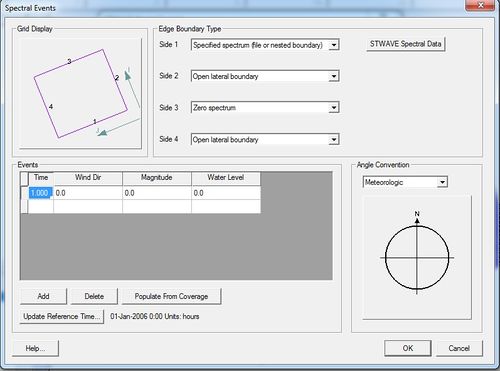SMS:Spectral Coverage: Difference between revisions
No edit summary |
|||
| Line 20: | Line 20: | ||
[[Category:SMS Map|S]] | [[Category:SMS Map|S]] | ||
[[Category:SMS Coverages|S]] | [[Category:SMS Coverages|S]] | ||
[[Category:SMS Dialogs]] | [[Category:SMS Map Dialogs]] | ||
{{stub}} | {{stub}} | ||
Revision as of 17:05, 23 November 2015
Spectral coverages are used to store all spectral data by location and time. These coverages are then used as spectral input for CMS-Wave and STWAVE, and are also used to view spectral output generated by the models in observation and nesting files.
Spatial Varied Boundary Conditions
CMS-Wave and STWAVE have the ability to read in spectral data from various locations defined in a nesting file. Within SMS, this spectral data is defined using a spectral coverage. Each node in this coverage can be assigned to any number of spectral grids and datasets which define the conditions at that location at any specific time.
Creating Spectral Data
To create spectral data at a node in the spectral coverage, right-click on the node and select Node Attributes.... This will bring up the Spectral Energy dialog, from which spectral grids and spectra can be created. See Generate/Edit Spectra.
Creating a Spectral Event
Related Topics
SMS – Surface-water Modeling System | ||
|---|---|---|
| Modules: | 1D Grid • Cartesian Grid • Curvilinear Grid • GIS • Map • Mesh • Particle • Quadtree • Raster • Scatter • UGrid |  |
| General Models: | 3D Structure • FVCOM • Generic • PTM | |
| Coastal Models: | ADCIRC • BOUSS-2D • CGWAVE • CMS-Flow • CMS-Wave • GenCade • STWAVE • WAM | |
| Riverine/Estuarine Models: | AdH • HEC-RAS • HYDRO AS-2D • RMA2 • RMA4 • SRH-2D • TUFLOW • TUFLOW FV | |
| Aquaveo • SMS Tutorials • SMS Workflows | ||
